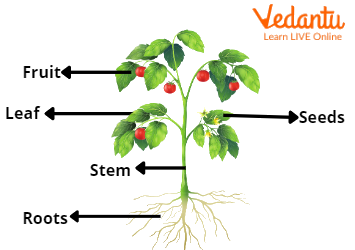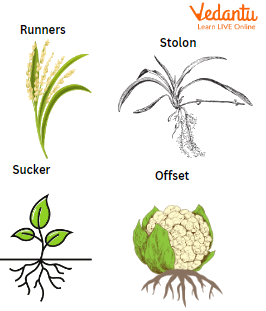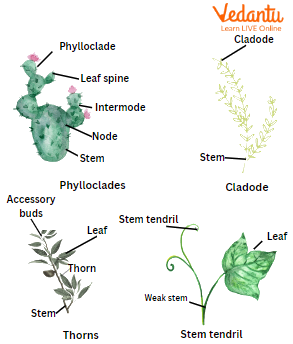Why Are Stems Essential in Plant Growth and Survival?
Plants are the biggest producer of oxygen on our planet. Plants take in carbon dioxide and return it through photosynthesis exhaling oxygen which is then inhaled by us humans while respiration. The plant has various organs and the central axis of the plant is the stem which bears all the organs. These plants have various parts which help have different functions. The six main parts are leaves, fruits, flowers, seeds, roots and stems.
What is a Stem?
In Botany, a stem meaning is an axis of vascular plants that appears from the roots, contains vascular tissues like the xylem and phloem, bears buds and shoots with leaves, and transports water, minerals and food to the other parts of the plants.

Structure of Plant
Definition of Stem
A Stem is defined as an ascending part or an axis of the vascular plant that bears branches, leaves, fruits and flowers.
Structure of Stem
The stem is divided into two parts
The Nodes - Give rise to the leaves and branches.
The Internodes - Separates two nodes.
The stem contains three basic types of tissues which are as follows:
Ground tissue,
Dermal tissue, and
Vascular tissue.
Epidermis: A single layer of cells making up the external tissue of the stem called the dermal tissue. Woody plants have an extra layer on top of the epidermis known as bark.
Ground Tissue - It is divided into two - the pith and the cortex which lie between the vascular tissue and the epidermis.
Pith - Central core of spongy tissue that is surrounded by strands and then by the cortex.
Cortex - It is divided into three layers.
Hypodermis - It is the outermost layer of the cortex.
General Cortex - It lies below the hypodermis.
Endodermis - Innermost layer of the cortex.
Growth in a Stem
Growth in a stem takes place in two different ways:
Primary Growth - In primary growth, the growth is achieved at the apical tips of the stem through the quickly dividing meristematic tissue.
Secondary Growth - It is the increase in the thickness of the stem through the lateral meristems.
Types of Stems along with Examples of Stems
Underground Stems - These stems produce aerial shoots and remain at the ground level. These stems store food and are capable of vegetative propagation.
Underground stems have many types which are listed below.
Rhizome - A rhizome is an underground stem that has distinct nodes and internodes. For example, Ginger.
Tuber - A horizontal swollen underground stem that expands at its growing tips due to the accumulation of stored food, commonly starch. For example, Potatoes.
Bulb - A short disc-like underground stem with an overlapping fleshy base with leafy scales. For example, onions.
Corm - A short, vertical, swollen unbranched stem of a plant that serves as a food storage organ. For example, Colocasia.

Types of Stem
Subaerial Stems
The stems that run parallel to the ground and do not rise above the ground are called subaerial stems. Subaerial stems have the following types:
Runner - A Runner runs horizontally to the ground and has long internodes. For example, strawberries and grass.
Offset - Offsets are short, less thickened branches with short internodes and arise from the axil of the lower leaves. These are often seen in aquatic plants. For example, Pistia.
Stolon - A stolon is similar to a runner but arises from the base of the main stem and often bends downwards touching the ground. For example, Mint.
Sucker - Suckers are similar to stolons. It grows obliquely underground before emerging upwards. For example, Chrysanthemum.

Sub-aerial Stem Modifications
Aerial Stems
Stems that are found above the ground are called aerial stems. Aerial stems have the following types:
Thorns - Thorns are hard woody and pointed structures that appear on the axils of leaves. For example, Roses.
Tendril - Tendrils are thin spiral coiled-like structures that are sensitive to touch. For example, Grapevines, pumpkins and cucumbers.
Bulbils - Bulbils store food and detach from the mother plant to develop into a new plant. For example, Dioscorea.
Cladode and Phylloclade - Phylloclade are flattened cylindrical stems whereas cladode is flattened stems that perform photosynthesis. Phylloclade can store water. For example, Ruscus.

Aerial Stem Modifications
Functions of Stems
The various functions of stems are listed below:
Stems support and hold leaves, flowers and fruits.
Stems play an important role in holding the plant upright.
The water and minerals are transported across the stem through the xylem and phloem present in the vascular bundle.
Some stems can store food and water.
Few green stems contain chloroplasts and are capable of photosynthesis.
The stems arrange the leaves in a way that they can receive sunlight directly to perform photosynthesis efficiently and also perform gas exchange.
Some stems are modified to perform vegetative propagation, a form of asexual reproduction in plants.
Pollination and fertilisation can be carried out with the help of stems which arrange the flowers and fruits in a position that makes it easier to perform.
Interesting Facts
In most plants, stems are appeared to be on top of the ground, but there are some stems that are found underground called stolons or rhizomes.
Except for the few plant stems, most stems are aerial that bear the other parts of the plant like flowers, leaves, fruits and seeds.
Key Features
A Stem is developed from the plumule of an embryo.
Stem fields play an important role in holding the plant upright in adverse conditions.
Several Stem fields are capable of storing water and food in desert conditions.
Some items are included in the daily diet and are edible such as rhubarb, celery and leaks.


FAQs on Stem in Biology: Definition, Types, and Key Roles
1. What is a stem in a plant and what are its primary functions?
In botany, the stem is the main ascending axis of a plant that bears branches, leaves, flowers, and fruits. Its primary functions include:
- Support: It provides structural support and holds the leaves in a position to receive maximum sunlight for photosynthesis.
- Conduction: It transports water and minerals from the roots to the rest of the plant through the xylem tissue, and transports food (sugars) from the leaves to other parts through the phloem tissue.
- Storage: Some stems are modified to store food and water.
- Vegetative Propagation: It helps in asexual reproduction in many plants.
2. What is the difference between nodes and internodes on a plant stem?
The two primary parts of a typical stem are nodes and internodes. Nodes are the specific points on the stem where leaves, branches, or aerial roots arise. Internodes are the sections of the stem located between two successive nodes. The length of internodes determines the height and spacing of leaves on a plant.
3. How does a plant stem transport essential substances like water and food?
A plant stem contains a sophisticated vascular system for transport. It uses two main tissues:
- Xylem: This tissue forms a network of tubes that transports water and dissolved minerals upwards from the roots to the leaves. This process is primarily driven by transpiration pull.
- Phloem: This tissue transports sugars (food produced during photosynthesis) from the leaves to all other parts of the plant where it is needed for growth or storage, such as roots, fruits, and seeds.
4. What is the main difference between a plant's stem and its root?
The main difference lies in their structure and growth direction. A stem is typically the ascending part of the plant axis, is positively phototropic (grows towards light), and is characterized by the presence of nodes and internodes from which leaves and buds arise. A root, conversely, is the descending part, is positively geotropic (grows towards gravity), and lacks nodes, internodes, and leaves. Roots have a protective root cap at their tip, which stems do not.
5. What are the different types of stem modifications with examples?
Stems are often modified to perform special functions. The main types of modifications as per the CBSE syllabus include:
- Underground Modifications: For food storage and perennation. Examples include Rhizome (ginger, turmeric), Tuber (potato), and Bulb (onion).
- Sub-aerial Modifications: For vegetative propagation. Examples include Runner (grass) and Stolon (jasmine).
- Aerial Modifications: For support, protection, and photosynthesis. Examples include Stem tendrils (grapevine, cucumber) for climbing, Thorns (Citrus, Bougainvillea) for protection, and Phylloclades (Cactus, Opuntia) for photosynthesis and water storage.
6. Is a potato a root or a stem? Explain your reasoning.
A potato is a modified stem, not a root. It is specifically an underground stem modification called a tuber, which is specialized for storing starch. The key evidence is the presence of 'eyes' on the potato's surface. These 'eyes' are actually nodes with axillary buds, a characteristic feature of stems. These buds can sprout to form new plants, which is a function of stems, not roots. Roots do not have nodes or buds.
7. What is the difference between the biological 'stem' and the educational acronym 'STEM'?
These are two completely unrelated terms. The biological 'stem' refers to the main structural axis of a plant that supports leaves, flowers, and fruits. The educational acronym 'STEM' stands for Science, Technology, Engineering, and Mathematics. It refers to a curriculum and educational approach that integrates these four disciplines to foster critical thinking and problem-solving skills.
8. How is the stem of a cactus plant adapted for survival in the desert?
The stem of a cactus is highly adapted to its arid environment. It is modified into a green, fleshy, and often flattened structure called a phylloclade. This modified stem takes over the function of photosynthesis, as the leaves are reduced to spines to minimize water loss. Its thick, waxy, and succulent nature allows it to store large amounts of water for use during dry periods.
9. Why do some plants like ginger and turmeric have stems that grow underground?
Stems like those of ginger and turmeric (called rhizomes) grow underground for two primary survival advantages. First, they serve as organs of perennation, allowing the plant to survive harsh environmental conditions like drought or extreme cold by remaining dormant underground. Second, they act as storage organs, accumulating food reserves. When favourable conditions return, the plant uses this stored energy to quickly sprout new shoots and leaves.
10. What are the main differences between a herbaceous stem and a woody stem?
The primary difference is in their structure and longevity. A herbaceous stem is soft, green, flexible, and non-woody, typically found in plants that complete their life cycle in one or two seasons. A woody stem is hard, rigid, and covered with protective bark. It undergoes secondary growth, which increases its girth over time, a feature characteristic of long-living plants like shrubs and trees.










